Exercise 3: Work with file relationships and trends in OneDrive
Microsoft Graph enables more features than just reading and writing files. In this exercise, you’ll learn how to get a list of files trending around a user and how to get recently modified and accessed files by the current user.
[!IMPORTANT] This exercise assumes you have created the Azure AD application and .NET console application from the previous unit in this module. You’ll edit the existing Azure AD application and .NET console application created in that exercise in this exercise.
Task 1: Update the Azure AD application
The first step is to add a permission grant to the Azure AD application that will enable the .NET Core console app to upload files to the signed-in user’s OneDrive account.
-
Open a browser and navigate to the Azure Active Directory admin center (https://aad.portal.azure.com). Sign in using a Work or School Account that has global administrator rights to the tenancy.
-
Select Azure Active Directory in the left-hand navigation.
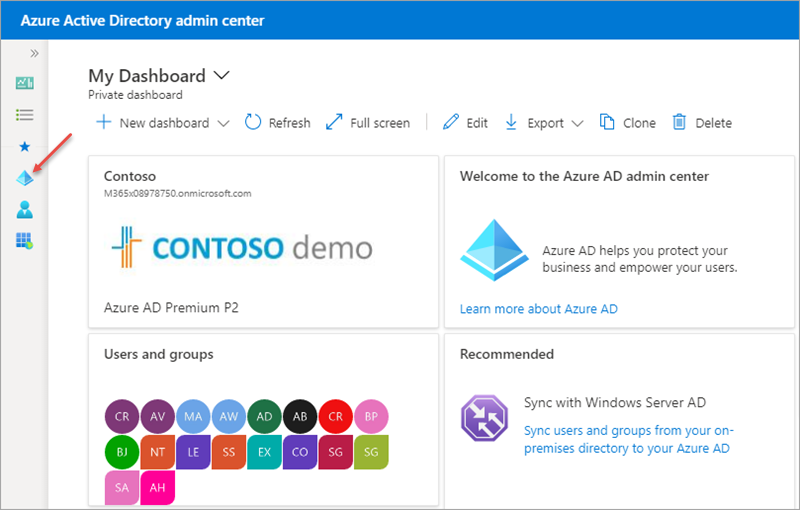
-
Select Manage > App registrations in the left-hand navigation.
-
On the App registrations page, select the Graph Console App.
-
Select API Permissions in the left-hand navigation panel.
-
Select the Add a permission button.
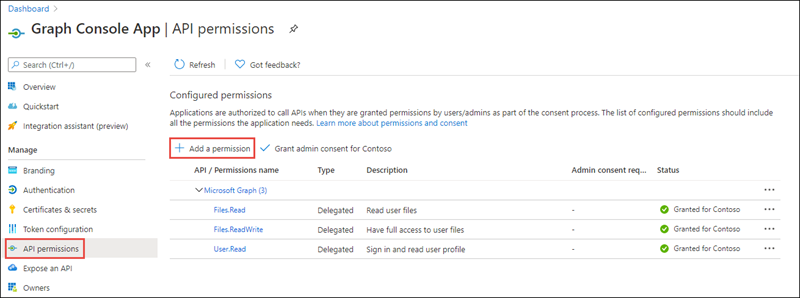
- In the Request API permissions panel that appears, select Microsoft Graph from the Microsoft APIs tab.
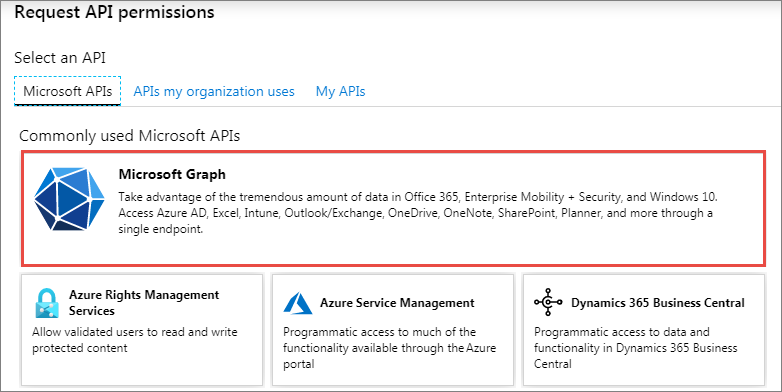
-
When prompted for the type of permission, select Delegated permissions.
-
Enter Sites.R in the Select permissions search box and select the Sites.Read.All permission, followed by the Add permission button at the bottom of the panel.
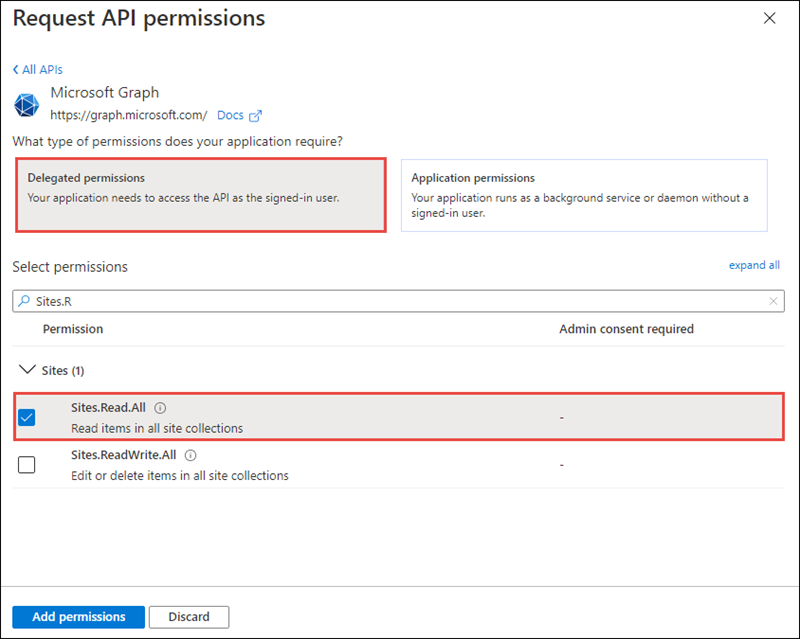
- In the Configured Permissions panel, select the button Grant admin consent for [tenant], and then select the Yes button in the consent dialog to grant all users in your organization this permission.
Task 2: Update .NET Core console application
In this section, you’ll update the .NET console app display all files trending around the currently signed in user.
- Locate the Program.cs file from the application you created in a previous unit in this module. Within the
Mainmethod, locate the following line:
Console.WriteLine("Hello " + profileResponse.DisplayName);
-
Delete all code within the
Mainmethod after the above line. -
Add the following code to the end of the
Mainmethod. This will get a list of all trending files around the currently signed-in user:
// request 1 - get trending files around a specific user (me)
var request = client.Me.Insights.Trending.Request();
var results = request.GetAsync().Result;
foreach (var resource in results)
{
Console.WriteLine("(" + resource.ResourceVisualization.Type + ") - " +resource.ResourceVisualization.Title);
Console.WriteLine(" Weight: " + resource.Weight);
Console.WriteLine(" Id: " + resource.Id);
Console.WriteLine(" ResourceId: " + resource.ResourceReference.Id);
}
Build and test the application
- Run the following command in a command prompt to compile and run the console application:
dotnet build
dotnet run
You now need to authenticate with Azure Active Directory. A new tab in your default browser should open to a page asking you to sign in. After you’ve logged in successfully, you’ll be redirected to a page displaying the message, “Authentication complete. You can return to the application. Feel free to close this browser tab”. You may now close the browser tab and switch back to the console application.
- The console app will display a list of files trending around the current user. Notice they’re sorted in descending order by their relative weight property:
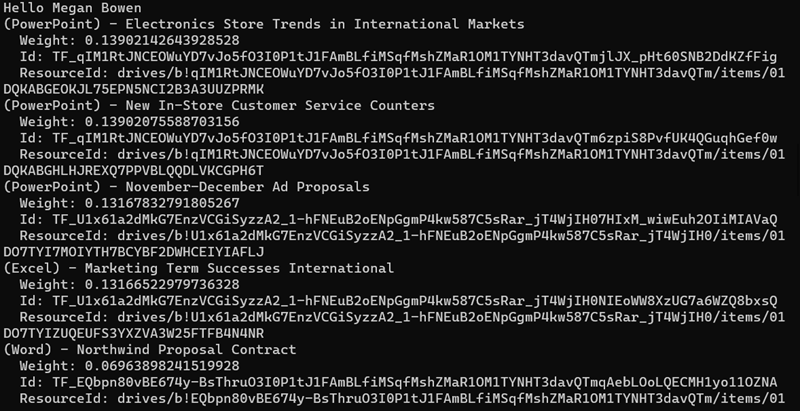
Task 3: List files accessed and used by the current user
In this section, you’ll update the .NET console app to display the files recently used and accessed by the currently signed-in user.
-
Locate the code you added above for
// request 1 - get trending files around a specific user (me)and comment it out so it doesn’t continue to execute. -
Add the following code to the
Mainmethod of the console application. This code will get a list of all files in the group’s root OneDrive folder and write the files to the console:
// request 2 - used files
var request = client.Me.Insights.Used.Request();
var results = request.GetAsync().Result;
foreach (var resource in results)
{
Console.WriteLine("(" + resource.ResourceVisualization.Type + ") - " +resource.ResourceVisualization.Title);
Console.WriteLine(" Last Accessed: " + resource.LastUsed.LastAccessedDateTime.ToString());
Console.WriteLine(" Last Modified: " + resource.LastUsed.LastModifiedDateTime.ToString());
Console.WriteLine(" Id: " + resource.Id);
Console.WriteLine(" ResourceId: " + resource.ResourceReference.Id);
}
Build and test the application
- Run the following command in a command prompt to compile and run the console application:
dotnet build
dotnet run
- After you’ve signed in, the console app will display a list of files recently accessed and modified by the current user:
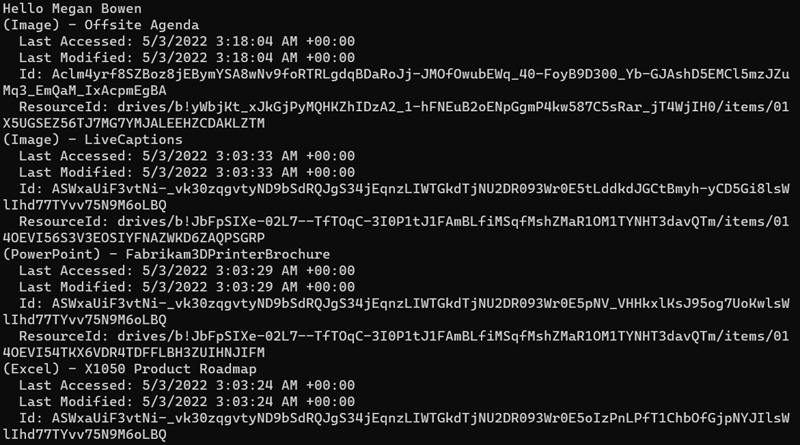
Summary
In this exercise, you learned how to get a list of files trending around a user and how to get recently modified and accessed files by the current user.